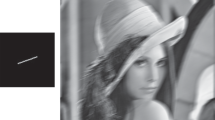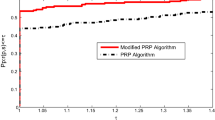Abstract
In grey-level image restoration, a prior knowledge of degraded areas allows, thanks to the selective filtering, to achieve a good protection of the image features. In this paper, we propose a quadratic programming-based technique that deals with the issue of details preservation during the restoration process. Based on the classical model of image restoration, we build a modified model by introducing a set of binary variables that indicate the pixel categories. We combine each pixel with the median of its neighbours in a decision rule so that one of them generates the optimal solution. The obtained model is a nonlinear mixed-integer problem where resolution by exact methods is not feasible. In this regard, we use both of the continuous Hopfield neural network and the genetic algorithm to solve the suggested model. Performance of our method is demonstrated numerically and visually by several computational tests.









Similar content being viewed by others
References
L. Alvarez, F. Guichard, P.-L. Lions, J.-M. Morel, Axiomatisation et nouveaux oprateurs de la morphologie mathmatique. Comptes rendus de lAcadmie des sciences. Srie 1, Mathmatique 315, 265–268 (1992)
J. Astola, P. Kuosmanen, Fundamentals of Nonlinear Digital Filtering (CRC Press, Boca Raton, 1997)
G. Aubert, P. Kornprobst, Mathematical Problems in Image Processing: Partial Differential Equations and the Calculus of Variations (Springer, Berlin, 2006)
A. Chambolle, V. Caselles, D. Cremers, M. Novaga, T. Pock, An introduction to total variation for image analysis. Theor. Found. Numer. Methods Sparse Rec 9, 227 (2010)
K. Dabov, A. Foi, V. Katkovnik, K. Egiazarian, Image denoising by sparse 3-D transform-domain collaborative filtering. IEEE Trans. Image Process. 16, 2080–2095 (2007)
D. Geman, G. Reynolds, Constrained restoration and the recovery of discontinuities. IEEE Trans. Pattern Anal. Mach. Intell. 14, 367–383 (1992)
S. Gu, L. Zhang, W. Zuo, X. Feng, Weighted nuclear norm minimization with application to image denoising, in Proceedings of the IEEE Conference on Computer Vision and Pattern Recognition (2014), pp. 2862–2869
J. Hadamard, Sur les problemes aux derive espartielles et leur signification physique. Bull. Princet. Univ. 13, 1–20 (1902)
P.C. Hansen, Analysis of discrete ill-posed problems by means of the L-curve. SIAM Rev. 34, 561–580 (1992)
J.H. Holland, Adaptation in Natural and Artificial systems: An Introductory Analysis with Applications to Biology, Control, and Artificial Intelligence. University of Michigan Press Ann Arbor (1975)
J.J. Hopfield, Neurons with Graded response have collective computational properties like those of two-state neurons. Proc. Natl. Acad. Sci. 81, 3088–3092 (1984)
N. Joudar, K. El Moutouakil, M. Ettaouil, An original continuous Hopfield Network for optimal images restoration. WSEAS Trans. Comput. 14, 668–678 (2015)
N.-E. Joudar, F. Harchli, E.-S. Abdelatif, M. Ettaouil, New adaptive switching scheme for impulse noise removal: modelling and resolution by genetic optimisation. Int. J. Signal Imaging Syst. Eng. 10, 316–323 (2017)
N.-E. Joudar, E. Zakariae, M. Ettaouil, Using continuous hopfield neural network for choice architecture of probabilistic self-organizing map, in First International Conference on Real Time Intelligent Systems (Springer, 2017), pp. 123–133
A.K. Katsaggelos, Digital Image Restoration (Springer, Berlin, 2012)
J.J. Koenderink, The structure of images. Biol. Cybern. 50, 363–370 (1984)
M.K. Ozkan, A.T. Erdem, M.I. Sezan, A.M. Tekalp, Efficient multiframe Wiener restoration of blurred and noisy image sequences. IEEE Trans. Image Process. 1, 453–476 (1992)
J.K. Paik, A.K. Katsaggelos, Image restoration using a modified Hopfield network. IEEE Trans. Image Process. 1, 49–63 (1992)
S. Park, Signal space interpretations of Hopfield neural network for optimization, in IEEE International Symposium on Circuits and Systems 1989 (IEEE, 1989), pp. 2181–2184
P. Perona, J. Malik, Scale-space and edge detection using anisotropic diffusion. IEEE Trans. Ppattern Anal. Mach. Intell. 12, 629–639 (1990)
L.I. Rudin, S. Osher, E. Fatemi, Nonlinear total variation based noise removal algorithms. Physica D: Nonlinear Phenom. 60, 259–268 (1992)
K. Sakthidasan, N.V. Nagappan, Noise free image restoration using hybrid filter with adaptive genetic algorithm. Comput. Electr. Eng. 54, 382–392 (2016)
P.M. Talavn, J. Yez, Parameter setting of the Hopfield network applied to TSP. Neural Netw. 15, 363–373 (2002)
P.M. Talavn, J. Yez, A continuous Hopfield network equilibrium points algorithm. Comput. Oper. Res. 32, 2179–2196 (2005)
A.N. Tikhonov, V.A. Arsenin, V. Kotliar, Mthodes de rsolution de problmes mal poss (1976)
S. Uma, S. Annadurai, Image restoration using modified recurrent Hopfield neural network. Int. J. Signal Imaging Syst. Eng. 1, 264–272 (2008)
U.-P. Wen, K.-M. Lan, H.-S. Shih, A review of Hopfield neural networks for solving mathematical programming problems. Eur. J. Oper. Res. 198, 675–687 (2009)
W.-R. Wu, A. Kundu, Image estimation using fast modified reduced update Kalman filter. IEEE Trans. Signal Process. 40, 915–926 (1992)
Y.-D. Wu, Q.-X. Zhu, S.-X. Sun, H.-Y. Zhang, Image restoration using variational PDE-based neural network. Neurocomputing 69, 2364–2368 (2006)
Y.-L. You, M. Kaveh, Fourth-order partial differential equations for noise removal. IEEE Trans. Image Process. 9, 1723–1730 (2000)
Y.-T. Zhou, R. Chellappa, A. Vaid, B.K. Jenkins, Image restoration using a neural network. IEEE Trans. Acoust. Speech Signal Process. 36, 1141–1151 (1988)
Z. Zuo, T. Zhang, X. Lan, L. Yan, An adaptive non-local total variation blind deconvolution employing split Bregman iteration. Circuits Syst. Signal Process. 32, 2407–2421 (2013)
Author information
Authors and Affiliations
Corresponding author
Rights and permissions
About this article
Cite this article
Joudar, Ne., Ettaouil, M. Mathematical mixed-integer programming for solving a new optimization model of selective image restoration: modelling and resolution by CHN and GA. Circuits Syst Signal Process 38, 2072–2096 (2019). https://doi.org/10.1007/s00034-018-0950-1
Received:
Revised:
Accepted:
Published:
Issue Date:
DOI: https://doi.org/10.1007/s00034-018-0950-1




